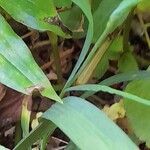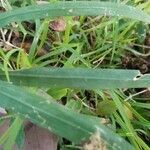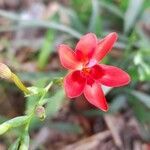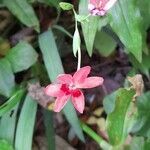Plants 20-35 cm. high.. Corms conical, round based, ± 1 cm. diameter, with tunics of fine reticulate fibres.. Foliage leaves several, narrowly lanceolate, soft textured, usually exceeding the spike.. Stem erect, usually unbranched.. Spike nearly horizontal, secund, 2-6-flowered; outer bracts 6-8(-13) mm. long, green, becoming membranous above, often dark brown apically, inner bracts slightly smaller than the outer, bifid.. Flowers zygomorphic, pink to red, or pale blue to white, with either darker red or blue-violet marks at the base of the lower 3 tepals; perianth-tube erect, slender, widening slightly at the apex, 1.8-3.3 cm. long; tepals subequal, broadly ovate to oblong 9-13 cm. long, held at right-angles to the tube.. Filaments unilateral and arcuate, exserted from the tube for 1.5-2 mm.; anthers 3-4 mm. long.. Style dividing between the base and middle of the anthers; branches ± 2.5 mm. long, deeply forked, often tangled among the anthers.. Capsules 9-12 mm. long, 8-10 mm. wide, nearly smooth to lightly papillose in the upper half.. Fig. 8/5.
Plants 20–35 cm. Stems erect or inclined, flexed outward below base of spike, usually branched, smooth. Leaves several, erect; blades usually shortly exceeding spike. Spike nearly horizontal, 2–6-flowered; spathes 6–8(–13) mm, outer slightly larger than inner, becoming membranous above, apex often dark brown, bifid. Flowers unscented, hypocrateriform; perianth tube cylindric, widening slightly at apex, 18–33 mm; tepals spreading at right angle to tube, pink to red [pale blue to white] with dark red [blue-violet] marks at base of lower 3 tepals, ovate to oblong, 9–13 mm; filaments exserted 1.5–2 mm from tube; anthers 3–4 mm; style branching between base and middle of anthers; branches ca. 2.5 mm, often tangled among anthers. Capsules 9–12 × 9–10 mm, sparsely papillose. Seeds 2–3 mm diam.
Perennial herb, geophyte, 0.1-0.3 m high; corm conical, 10 mm in diam.; stem erect, unbranched. Leaves lanceolate, usually exceeding spike. Bracts with dark brown apex; outer bracts bifid. Inflorescence a 2-6-flowered spike, horizontal, secund; perianth zygomorphic, pink to red or pale blue to white; tube erect, slender, widening at apex; tepals unequal, held at right angles to tube. Stamens unilateral, arcuate; anthers 3-4 mm long. Ovary with style branching between base and middle of anthers, branches 2.5 mm long, usually tangled among anthers. Flowering time Oct.-Feb. Capsule 9-12 x 8-10 mm; upper half lightly papillose.
Herb to 30 cm high. Corm conical, c. 1 cm diam. Basal leaves linear-ensiform, 10–30 cm long, 3–6 mm wide, glabrous; midvein prominent. Scape terete, shorter than leaves. Spike unbranched, 3–6-flowered. Bracts ovate, 5–7 mm long. Perianth pink or pale blue; tube slender, slightly widened at apex, 1.5–2.5 cm long; lobes spreading, ovate to oblong, sub-equal, 7–12 mm long, the lower 3 marked with red or purple. Style branching above anthers. Capsule c. 1.2 cm long. Seeds c. 1 mm diam., lustrous, dark red. [See also Green (1994: 519), as Anomatheca laxa.]
Cormous herb, up to 300 mm tall. Perianth segments broadly ovate to oblong, held at right angles to tube. Tube 20-30 mm long. Flowers red or bright pink.




